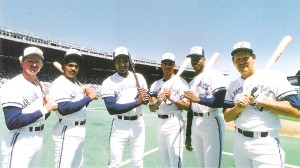A look into the team’s ascension to greatness and its heydays
Staying competitive while passing the torch

Orioles on September 14, 1987, showing just how powerful Toronto’s line up was in the 1987 season. Photo
credit: backinblue.kc-media.net
I always felt that the 99-62 Toronto Blue Jays were cheated out of a World Series appearance in 1985, as the team was leading with three games to one over the Kansas City Royals before losing the series in seven games in heartbreaking fashion. It was especially devastating since 1985 was the first year in which the League Championship Series was changed from a best-of-five format to a best-of-seven format. Despite the setback, the team was clearly on the rise and so loyal fans of the club knew that Toronto’s postseason was not a fluke and that the Blue Jays would make their way back to the playoffs in the not too distant future.
After falling back to earth somewhat in the 1986 season, in which the team finished in fourth place in the American League East, even though the club was ten games above .500 at 86-76, Toronto put together one of its most memorable seasons in 1987, which ended when the Blue Jays lost the division crown to the Detroit Tigers on the final day of the regular reason. Even late into the season, Toronto looked poised to capture its second American League East division title in three years as the Blue Jays led the Detroit by three and a half games with only eight games left in the season. By all accounts, the Tigers had to win all of their remaining games and Toronto would have had to lose all of its remaining games in order for the Tigers to overtake the Blue Jays, which against all odds, is what transpired in the end. For the most part, Toronto’s collapse (going 0-7 to finish the season with a 96-66 record and two games behind Detroit) was not a function of a sudden dip in performance; rather, it could be attributed to a very untimely rash of injuries as several key starters, such as Tony Fernández (who broke his elbow after being taken out by Tigers infielder Bill Madlock) and Ernie Whitt, suffered season-ending injuries that robbed the team of its offensive power.
Still, despite coming out of the showdown on the losing end, Toronto demonstrated that it was a force to be reckoned with for years to come. The Blue Jays had demonstrated their status as a genuine contender. By this point, Toronto featured a strong starting lineup as the batting order had batters with high batting averages who could get on base on a frequent basis (Bell and Fernández), with speed to burn on the bases, gold-glove calibre defence (Fernández and Moseby), and strong power hitters (Barfield, Bell, McGriff, Moseby, and Whitt). The starting rotation was equally strong as both Stieb and Key continued to star (given that both of them were still very much in their prime) while Jim Clancy complemented Stieb and Key nicely as an excellent number three starter (as he had been putting front-of-the-rotation numbers in 1982, 1983, and 1987).
Six Blue Jays players combined to blast a Major League Baseball record ten home runs in a game against the Baltimore Orioles on September 14, 1987, showing just how powerful Toronto’s line up was in the 1987 season.
Between 1988 and 1990, the Blue Jays continued to be a very competitive team. The club surprised all the critics to win their second American League East division title in 1989 by recovering from a disastrous 12-24 start which saw Cito Gaston replaced by Jimmy Williams as manager. We also began to see a changing of the old guard as some of the long-time core position players who were exiting their primes departed through unrestricted free agency (Clancy in 1988, Moseby in 1989, and Bell in 1990) or got traded (Barfield in 1989 and Whitt in 1990). A number of new rising stars subsequently became staples of the team after establishing themselves, including catcher Pat Borders, third baseman Kelly Gruber, and first baseman John Olerud. As for the bullpen, the addition of setup man Duane Ward formed an enviable one-two punch at the backend of the bullpen that instilled fear into opponents (Henke and Ward dominated so much that the game was often over after seven innings if the starting pitcher could hold a lead until Ward in the eighth and Henke in the ninth).
From the mid-to-late 1980s, the team was playing competitive baseball year in, year out, and were twice crowned American League East champions. Still, the inability to win it all and bring a World Series title to Toronto continued to haunt the reputation of the franchise, especially after the club got dispatched by the powerful Oakland Athletics in five games in the 1989 American League Championship Series. To be fair, it was a long shot for the 89-73 Blue Jays to win the series. On the other hand, the Oakland lineup was stacked with star players such as Dave Henderson (center fielder), Rickey Henderson (left fielder), Carney Lansford (third baseman), and Mark McGwire (first base). The Athletics’ pitching staff was equally fearsome as the starting rotation was led by a trio of dominating starters in Dave Stewart, Mike Moore, and Bob Welch, while the bullpen was anchored by the virtually unhittable Dennis Eckersley. Indeed, the 1989 edition of the Oakland Athletics was so powerful that José Canseco was used as a bench player.
However, it would not be long before Toronto finally reached its destiny and won back-to-back World Series in 1992 and 1993. To understand how and why the Blue Jays shook up its roster, be sure to stay tuned for Part 3 of my article.
